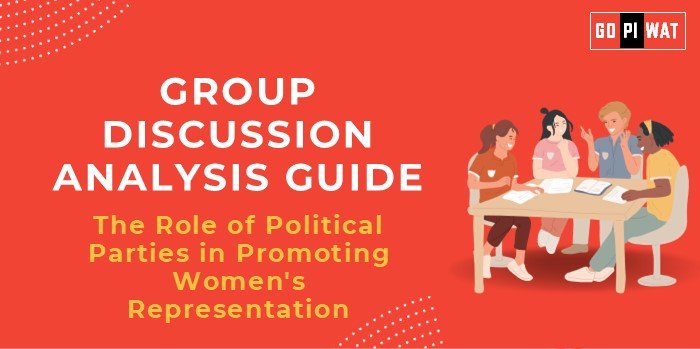📋 Group Discussion Analysis Guide: The Role of Political Parties in Promoting Women’s Representation
🌐 Introduction to the Topic
- 📖 Opening Context: The underrepresentation of women in politics remains a global concern despite numerous advancements in gender equality. Political parties play a pivotal role as gatekeepers of political opportunity and are crucial in addressing this disparity.
- 🌍 Topic Background: Globally, women occupy only about 26.7% of parliamentary seats, highlighting systemic barriers. India, with a 14.94% representation in the Lok Sabha (2024), trails behind the global average. While constitutional measures like reserved seats exist in local governance, political parties remain critical in mainstreaming gender inclusivity through candidate selection, policy advocacy, and mentorship.
📊 Quick Facts and Key Statistics
- 🌏 Global Parliamentary Representation: Women hold 26.7% of parliamentary seats globally (UN Women, 2024).
- 🇮🇳 India’s Position: Women occupy 14.94% of Lok Sabha seats as of 2024.
- 📜 Quota for Women in Local Governance: 33% reservation in Panchayati Raj institutions since 1992.
- ⚖️ Political Party Reforms: Only a few Indian parties mandate a 33% internal reservation for women in decision-making roles.
🤝 Stakeholders and Their Roles
- 🏛️ Political Parties: Identify and promote women candidates, create inclusive policies.
- ⚖️ Government: Enact and enforce gender quota policies.
- 📢 Civil Society and NGOs: Advocate for reforms, train women leaders.
- 🌍 International Bodies: Provide benchmarks and funding for gender equity programs.
- 🗳️ Voters: Challenge stereotypes, demand more women in leadership.
🏆 Achievements and Challenges
✨ Achievements:
- ✅ Local Governance Success: Women’s representation in Panchayati Raj exceeds 44% in some states due to quotas.
- 🌟 Notable Leaders: High-profile leaders like Indira Gandhi and Mamata Banerjee have demonstrated women’s leadership potential.
- 📋 Policy Advocacy: Introduction of the Women’s Reservation Bill in 2008 (though still pending).
⚠️ Challenges:
- 📉 Party-Level Barriers: Limited tickets for women candidates in elections.
- ⚖️ Cultural and Societal Norms: Gender biases discourage female political participation.
- 🌏 Global Comparisons: Nordic countries, with over 40% representation, showcase the impact of robust gender quota systems.
📄 Case Study:
- 📌 Bihar: Early adoption of Panchayati Raj quotas has resulted in higher literacy rates and enhanced healthcare outcomes in rural areas led by women.
💡 Structured Arguments for Discussion
- 📢 Supporting Stance: “Political parties are pivotal in bridging gender gaps by offering women opportunities in leadership roles.”
- ❌ Opposing Stance: “Despite claims of inclusivity, many political parties prioritize tokenism over genuine representation.”
- ⚖️ Balanced Perspective: “While some parties have championed women’s rights, systemic changes across the political spectrum remain necessary.”
📌 Effective Discussion Approaches
🎯 Opening Approaches:
- 📊 Begin with Statistics: Highlight global and national statistics on women’s representation.
- 📜 Case-Based Start: Highlight a successful case study, like the Panchayati Raj system.
🔄 Counter-Argument Handling:
- 📋 Acknowledge limitations (e.g., quota misuse).
- 🛠️ Propose solutions (e.g., gender sensitization programs within parties).
📚 Strategic Analysis of Strengths and Weaknesses
- 💪 Strengths:
- 🌟 Established women leaders in Indian politics.
- 📈 Increased awareness of gender equality.
- ❌ Weaknesses:
- 📉 Persistent biases against women in politics.
- ⚖️ Lack of enforcement mechanisms for quotas.
- ✨ Opportunities:
- 📜 Gender quotas in political parties.
- 🤝 Civil society partnerships for leadership development.
- ⚠️ Threats:
- 📢 Political tokenism undermining genuine inclusion.
- ⚖️ Backlash from conservative groups.
🎓 Connecting with B-School Applications
🌐 Real-World Applications:
- 📋 Gender equity initiatives within organizations modeled on political reforms.
- 📊 Policy design for inclusive leadership frameworks.
❓ Sample Interview Questions:
- ❓ “What are the key barriers to women’s political representation in India?”
- 💡 “Can private sector gender equity practices inform political reforms?”
📈 Insights for Students:
- 📖 Consider policy analysis projects on political representation.
- 🌟 Explore leadership models driven by women’s participation in politics.


